|
The K.D. Smith Collection.
(c)By Edward A. Sharpe Archivist,
Southwest Museum
Of Electricity and Communications (Now SMECC)
Reprinted form SMEC "Vintage Electrics" Volume 2 #1
K.D. Smith, while a member of technical staff of Bell Telephone Laboratories
as a staff engineer, had access to what seemed to be an unlimited supply
of early experimental examples of solid state technology. Apparently when
something was to be disposed of, K.D. would save it. When I asked Jim Early,
a colleague of K.D. Smith, if he or anyone else had managed to save any
of similar material as K.D. Smith had, he told me no, that K.D. was the
only one that had made a systematic effort to collect up some of it.
Although the folks that sorted through the immense collection of
old radio tubes, transistors, and assorted items assumed that K.D was merely
a pack rat; it has become a proven fact that things were saved for a purpose
once you analyze the material at hand and reviewed the reference material
published by The Bell System. Within seconds I recognized the artifacts
at hand as being historically significant, and within just hours realized
why many of the items had been saved.
One reference source that serves as a extremely valuable resource
are the lab notebooks full of comments that K.D. Smith kept at home. Many
times the information was a duplicate of what he put in the formal notebooks
that Bell Labs required employees to keep that would be witnessed to support
patent cases. Often though, the thoughts he would jot down were just things
that came to mind and he wanted to keep a record of.
Some of the most enjoyable reading in his journals are the records
of what K.D. called "PARTLY BAKED IDEAS", which he often referred
to in an abbreviated form as "PBI's". They were either brief
introductions to a possible invention, or in many cases just a record of
a possible way to solve a problem that was at hand.
There were times that were noted in the books that he became rather
frustrated in maintaining order in this large collection of artifacts,
and at one point on the vacuum tubes, he allowed himself to keep only a
maximum of 10 of each type! When it came to early solid-state devices however,
`THE MAXIMUM OF TEN RULE' Did not seem to apply! If one was to judge the
fondness for a development project, based on the amount of artifacts that
were kept, the clear winners would have to be M-1752 junction transistors
and Bell Solar Batteries (solar cells).
K.D. made other references in these notebooks that the material needed
to be sorted and categorized. Apparently some of this action was carried
out, as you would find some of the most profound artifacts in shoe boxes
marked `MUSEUM'! Envelopes that were in these shoe boxes had transistors
grouped together in them. Many of the envelopes were the original filing
envelopes that the devices had lived within all of there lives accompanied
by the measurement data on the part. This data was very instrumental when
Howard Dicken wanted to see how the parameters had changed in the time
since the device's date of manufacture (see the article on this subject
by Howard in this copy of VINTAGE ELECTRICS).
In one document that is among K.D.'s notes from the early days, a
list provides some great insight as to what K.D. felt were historical or
landmark devices. In reviewing this list I whole heartily agree with his
selection. At the time the technology was new he had fantastic foresight
as to what we would be excited about this many years later!
I wish I had K.D. Smith sitting next to me to explain what some of
the items that he had in his collection were, the stories behind them,
what had led the developers to the point that the device represented, and
to explain to me just what some of the items are! In any collection of
artifacts, the person that does the collecting always has the greatest
insight on the artifact itself.
K.D. Smith is to be commended for his collecting efforts. Had he
not collected in such a large scale manner, the world would be without
many examples of the early solid state technology. Although the Bell Patent
Department has examples of each M series part, we are not sure that they
possess the variations that we have come across here.
Fortunately I have made a number of fine new friends out there that
worked with K.D. back during the glory days of transistor development at
Bell Laboratories. I can not express enough gratitude for the patience
and insight afforded this thankful archivist by Jim Early and Bob Ryder.
Without the help of these two associates of K.D. Smith's I would have been
traveling uncharted waters without guidance.
Many long hours of discussion and teaching were done by existing
friends, namely Morgan McMahon, Jack Saddler and Howard Dicken. You will
also see articles by these fine scholars here also in this publication!
Yes, I had used transistors since third grade, but had never learned the
history of the development, processes involved in manufacture or how the
companies were born and died. I have all of these folks to thank!
How the collection came to the museum.
K.D. Smith had passed away and the Smith family contacted Clem Chase,
a radio amateur and also at that time president of The Quarter Century
Wireless Association, to help the Smith family dispose of some radio equipment.
What Clem thought would be the contents that would fill just a couple
of boxes, turned out to be an entire truck load of the wildest assortment
of parts and equipment that Clem had seen!
Clem Chase at this point enlisted the help of two other radio amateurs
and fellow members of QCWA, Harry Snyder and Gerry Higgins, from Carefree
Arizona. Clem drove the truckload of goodies up from Tucson, where they
were deposited on Gerry Higgins garage floor to be sorted. The truckload,
when spread out took a good part of Gerry's garage space! The sorting process
took 3 days, being primarily done in the morning, due to the extreme heat
we are endowed with in the summer here in Arizona.
The collection at this point consisted of radio tubes, transistors
of what appeared to be of an early nature, books, circuit boards, hardware,
scraps of wire, old transformers, odd brass looking objects, scrap metal
and amateur equipment. There were also thousands of short lead components
suitable for insertion into PC boards that K.D. had kept for future project
use.
It seemed most odd that there were only a small grouping of books.
Usually in our experience, anyone that has this much
The K.D. Smith Collection, Cont.
equipment and parts also has a vast quality of books magazines and papers!
Harry told me that was all that they had seen in the batch, and offered
no explanation as to why there were so few.
After I had sat for an hour and read through the books, I noticed
that they all contained articles by K.D. Smith. It was clear at that point
that K.D. had been one of the pioneers in the early Bell Laboratories transistor
efforts.
I then called all of the people that I knew! I wanted to know if
they had heard of K.D. Smith, and what these folks knew about early transistor
history.
I found that I had an excellent reference library sitting right next
to me in the form of BELL SYSTEM TECHNICAL JOURNALS and The Bell Laboratories
RECORD. In the pages of these fine journals, the history of the Bell Telephone
Laboratories progress is contained!
I also called K.D.'s son Dave Smith, and Dave sent us many papers
and notes that K.D. had saved during his time at Bell Laboratories.
Discovery of the Morton tube.
I had seen pictures of the Western Electric 416 tube prior to my
encounter with this collection, so when I saw what appeared to be a 416,
I was able to recognize it instantly. In my further searches through the
collection I found what looked to be a crude 416 tube. It had many of the
same aspects as the 416, but instead of having the nicely gold plated pins
coming out of the bottom of it, there were wires protruding from the base
acting as the connection! The more I inspected the tube, the cruder it
looked! Yes! You guessed it! This was one of the early prototypes of the
famous 416 triode, or as it is known by Bell Laboratories folks I know,
as "The Jack Morton Tube" or as "The Morton Triode".
This tube was the heart of the trans-continental microwave communications
network called the TD-2. This system, although not known to all of us by
name, nevertheless, has been a part of our lives for a long time. The TD-2
carried , in the days before satellites, all of the cross country TV network
programming, as well as long distance phone calls.
At this point I contacted Bob Ryder, a former Bell Laboratories employee,
and friend of K.D. Smith. In addition Morgan McMahon introduced me to Jim
Early. Both of these fine folks were very helpful in educating me as to
what was here in the collection.
I also called John Bardeen, inventor of the transistor. He did not
know K.D. Smith very well, as he had left Bell Laboratories in 1951 to
teach at the University of Ill. John did, however, send us an early transistor
and spec. sheet that he had been sent after the 1952 teachers meeting at
the Laboratories (see article "Teachers Taught About Transistors"
in this issue).
I finally met Dave Smith in person at the 75 Ave. off-ramp and Interstate
10 in Phoenix. He was going back to Santa Barbara, and had found a batch
of interesting papers of K.D.'s for us at the museum. We were actually
supposed to meet at 67 Ave. and the interstate near a three story hotel
that LeeAnn told us was there. However I guess we both got there and there
was no hotel
at 67 Ave. and the freeway!! We both called LeeAnn for help, my call was
first and I told LeeAnn that I would be at a Circle K at the intersection
of 67 and McDowell, just north of the freeway. I cruised around awhile
and called again. The line was busy so I called the other line and she
said Dave was on the line and she had passed the info to him as to where
to meet! I went on down the road and ended up at the Circle K just as Dave
was pulling up.
After a greeting session, Dave showed me a few of the contents of
the box he had brought up from Tucson for us. Unknown to either of us,
there was a policeman watching both of us, and he came up and asked what
we were selling. I guess, looking back on it, that we must have appeared
rather odd with cars from two states and our greeting and exchange of old
cardboard boxes!
WHAT DOES THE COLLECTION CONSIST OF?
In the future displays of the K.D. Smith Collection at the Southwest
Museum of Electricity and Communications you will find many items of interest.
Among these but not limited to, are the following list of areas to give
you a brief introduction and wet your appetite!
- The K.D. SMITH MEMORIAL -
This display shows pictures of K.D. Smith at various ages. In addition
there are photos of him working on various projects at Bell Laboratories.
You will also note the listing of all of the projects that he had involvement
with during his 40 years at Bell Laboratories. In addition to his ability
to collect artifacts from the era that he existed in, K.D. was a very productive
engineer and had the ability to work on very diverse projects.
- BOOKS ON SOLID STATE -
Early books published by Bell Laboratories on solid state. These
are also supplemented by books given to us by Jim Early, Bob Ryder and
Morgan McMahon. In addition to all of this, the semiconductor library is
supplemented by the museum's collection of BELL LABORATORIES RECORD and
BELL SYSTEM TECHNICAL JOURNALS, that have been here for reference here
for quite a while.
- BELL TELEPHONE LABORATORIES NOTES -
There is large collection of preliminary sketches of devices made
before they were actually produced. Included also are rough drafts of papers
that K.D. presented at conferences. The rough drafts of letters he sent
to fellow workers and supervisors show some of the problems that were experienced
during device development, and what was done to work out the problems.
One of the more fascinating aspect of this paper collection are the
Status Reports, Memoranda For Record, and Technical Memoranda that were
issued during the progress of the development of devices. The content of
these items cover cost estimates of material and capital equipment for
manufacturing and estimates of quality to be produced and the time frame
to accomplish it in.
The distribution list on the last page of the above mentioned type
of reports reads like a Who's Who of the early semiconductor pioneering
effort! Even these distribution lists provide insight, as each project
would have certain of the engineers and scientists involved with it. The
distribution list tells you which of them was informed of it!
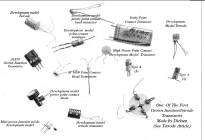 click for larger view of all the early
transistors!
click for larger view of all the early
transistors!
- THE OVERVIEW -
There is also a display showing some of the various types of solid
state devices that Bell Laboratories developed that were part of K.D. Smith's
preservation efforts. It will give you an overview of diodes, transistors,
varistors, thermistors and solar cells.
- INSIDE THE TRANSISTOR -
Besides the devices themselves, there are small displays that were
built by Bell Laboratories that show the manufacturing process that the
device progressed through, each display is like an exploded view of a component,
but implemented in actual parts rather than just a drawing! Feel free to
use the magnifier hanging next to the display to examine Point Contact,
Grown Junction, Alloy, Diffused Base and other types of transistors that
are on display!
- THE BELL SOLAR BATTERY -
Many different forms of solar cells and some historical examples
are displayed. These solar cells were called BELL SOLAR BATTERIES, and
there are examples as they devel
oped from crude prototypes into the more advanced form that was used on
satellites.
Historical samples include one of the arrays that was made up for
the first transistorized repeater experiment that took place high a telephone
pole in Georgia in 1958. These are the early design P on N Bell Solar Batteries.
A variant of the cells that were in this array can be seen encapsulated
into a solid block of plastic. There are three cells in this block, and
this artifact was used in the late 1950's as a lecture aid by Bell Laboratories
staff.
The final historical grouping are examples of Bell solar batteries
that were slated for the TELSTAR I project. These were the brothers of
the actual cells that went up on the satellite, but alas even though made
from some of the same silicon crystals as their brothers, they did not
pass the rugged tests that constituted the selection process. Some went
up to generate power for the first television relay via satellite, and
some remained earthbound to be collected by K.D. Smith and to arrive here
at the museum for your viewing enjoyment!
Most of these cells work and output a half a volt each, however,
there may be discoloration to the surface, or they did not produce the
desired current, or worst case - there are some dead ones also!
We have also included as many pictures in the display as we can,
so that you might see what these components actually looked like when their
brothers were producing power in examples of amplifying telephone calls
to powering TELSTAR I!
These solar cells were quite a bit different from their predecessors.
Not only are they rectangular rather than round, but these cells are made
with N on P structure to increase power output and lowered radiation damage
effects. To armor them up for their cosmic experience, each cell is protected
by a window of synthetic sapphire.
There is one of the Bell Solar Batteries out of the TELSTAR batch
hooked up to a meter so you will be able to see it functioning. It is rather
fun to pass your hand in front of it and watch the deviation of the meter
as the light striking it's surface is diminished by the shadow your hand
causes.
- DIODES -
Diodes! Some of these date from Before the WW-2 era. This was the
solid-state effort that Bell Telephone Laboratories was involved in prior
to the invention of the transistor. Even after the invention of the transistor
there was much research being done on diodes also. Such items that are
on display that came out of that effort are the IMPATT Diode, Varactors,
improved Varistors, PIN diodes and more! Those amazing diodes.... not just
a crystal detector once the BTL folks started working on them!
- TRANSISTORS -
There is a great type collection of transistors arranged in chronological
order by M and A series numbers that Bell Laboratories assigned to projects
at their inception. There are transistors here that the only place they
were truly seen was inside the lab itself, as many never made it past the
experimental stage!
Remember, Bell Telephone Laboratories developed transistors, Western
Electric made them, and the Bell operating companies consumed them. Although
Bell Laboratories was without a doubt the leader in solid state development,
they, nor did their brother companies really sell transistors to the end
users. They did, however, license the manufacturing processes and the technology
they invented to other companies. These companies Such as TI, RCA, GE,
HUGHES and others would build for the end user customer.
There were exceptions to this practice of internal consumption though.
Western Electric did have a lot of government contracts. These contracts
consisted of radar, microwave relay, missile guidance systems, and communications
packages to go into government and NASA satellites.
WHOSE NEEDS DOES THE COLLECTION ADDRESS?
This collection of early Bell solid state devices, outside of visiting
the Bell Patent Department, is the most complete type collection of its
type in the country. In addition to the devices there are examples of the
literature, manufacturing tools, and parts that were used to make up the
various solid state devices.
Students who are studying semiconductor manufacture can
actually see how the early devices were assembled. There are samples of
the actual germanium and silicon grown crystals that they can study. The
process continues with slices from the grown crystal and on to the bar
itself that would have leads attached to it. The most complete manufacturing
sample file is associated with the M1752 grown junction germanium transistor,
the very one that K.D. spent quite a bit of his time helping develop.
The library offers to anyone an outstanding collection of the birth
of the era of solid state. It is a relatively small section of the museum's
library due to the fact that not much literature was published prior to
1952 on solid state. In era following 1952 the quantity of books almost
seems to blossom! We have folks like Morgan McMahon, Jim Early and John
Fairfield to thank for their submittal of many of these. we are always
looking for more to supplement this section.
The person who is in management may want to study some of the yield
figures that we have for the early devices. statistical information is
available in the form of Bell Laboratories status reports that outline
exactly what state the project was at the time of the report being issued.
The beginning student in the electronics field is treated to artifacts
that show solid state in its infancy and simplistic form. The displays
in which transistors are shown in their assembly stages serve to de-mystify
what exists within the sealed can they are learning to build and design
with. Of course, the early literature acquaints them with the historical
development of solid state. This is a chance to be exposed to many things
that are not possible within a classroom environment!
Diodes - Transistors, the solid state components in integrated circuits.
For a student to fully realize the impact of what he will be designing
now, it is important to study how the devices that preceded his impacted
the world around him. All of this information is at his fingertips.
To the person doing historical research, the K.D. Smith Collection
is a vast asset. The researcher not only has actual hardware artifacts
but the printed material to draw upon. The museum functions as a centralized
reference resource not only covering the early days of solid state, but
also embraces electrical and communications technology dating back close
to the very earliest inception of the technology itself. - EAS
The Life Of K. D. Smith At Bell Laboratories By Edward A. Sharpe
1930-1940
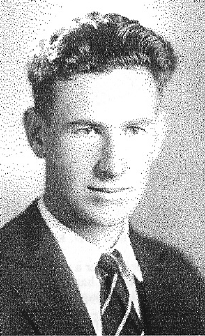
K.D. Smith was involved with the development of test methods and
electronic test equipment relating to carrier systems, coaxial cable terminals
and field tests.
We are fortunate to have a large notebook that K. D. Smith saved
with some of the memorandums he authored and co-authored. The first of
these is dated Oct. 1, 1931, created by K.D. soon after his arrival at
Bell Laboratories (remember, he started in 1930), it is entitled "Dynamic
Cutoff of Vacuum Tubes". The last in this notebook is dated Mar. 23,
1936; and contains a review of the Boonton Radio Corporation `Q METER'.
This notebook gives some insight as to what K. D. Smith was involved
with, but presents only a partial picture by itself. However when you couple
it with the Bell Laboratories RECORD magazine, and the BELL SYSTEM TECHNICAL
JOURNAL issues that we have in the museum, we will be able to portray a
more complete picture... With a bit more research.
1941-1944
America went to war during this segment of K. D. Smith's career.
During this epoch he was involved with the development of proximity fuses
on behalf of Division 4, National Defense Research Committee. In fact,
he was a consultant to the NDRC from 1941 until 1943.
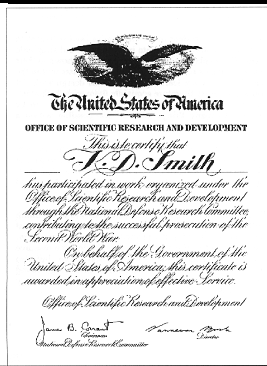 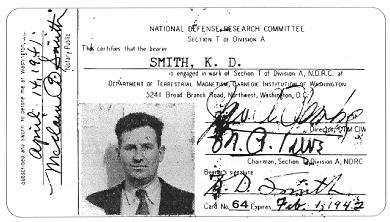
Since this was a extremely classified project, he did not collect
much in the way of artifacts or written material to take home during this
time.
Seen here in VINTAGE ELECTRICS, along with this article is a picture
of K. D. Smith's NRDC ID card. At the end of World War II K.D. Smith was
presented with an award from Office of Scientific Research and Development
through the NDRC for "Contributing To The Successful Prosecution Of
The Second World War". A much reduced copy of this certificate is
shown here, as well as a full size version of this document on file in
the museum.
1944-1945
Radar - our nation's eyes to protect us against from the unseen enemy
forces and to guide our bombs to their precise targets through the darkness
of night!
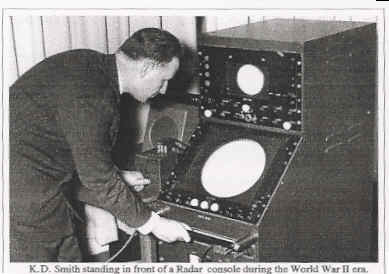
K.D. Smith was working on the development of RADAR at Bell Laboratories
during these years, and in 1945. One of his notes references that he was
project engineer on the AN/APQ 13 and the AN/APQ 23.
For the person wishing to do research on the World War II RADAR efforts
at Bell Laboratories, they will wish to consult the BELL SYSTEM TECHNICAL
JOURNAL which in the late 1940's contains many in depth articles and pictures
that show and explain the Bell System's involvement with the development
and manufacture of RADAR equipment.
1946-1947
K.D. Smith at Bell Laboratories, Cont.
K.D. Smith was project engineer on the TE-1 and TE-2 short haul microwave
relay system intended for Television studio to transmitter site service;
and for repeatered routes of 2 to 3 links. The TE-1 system operated between
3.7 and 4.2 Gigahertz.
An excellent explanation of this system can be found in a publication
entitled "A New Microwave Television System" that K.D. Smith
co-authored with J.F. Wentz. This talk was presented at the winter meeting
of the AIEE in January 1947, and the paper was printed in the Transactions
for the AIEE Volume 66, pages 465-470 in 1947.
For an in depth look at what it was like to set up the first test
between Hollywood and Mount Wilson, we have on file K.D. Smith's Field
notes of this event. It chronicles the events from unboxing the equipment
through the successes and problems that were encountered!
1948-1951
K.D. Smith was the circuit design supervisor on the TD-2 Microwave
Radio Relay System. The TD-2 was the backbone trans-continental microwave
relay system carrying network television programming as well as long distance
telephone traffic. Long before communications satellites were a practical
reality, the TD-2 system was what brought us the television shows we so
much enjoyed from the network studios in New York, and gave us enough long
distance telephone connections to talk to Aunt Martha back on the Eastern
seaboard during Christmas day!
K.D. Smith's specific responsibility was the F.M. terminal systems
used in the TD-2. The F.M. terminal converted video signals to a 70 MHz
frequency modulated signal that modulated the microwave transmitter circuit
that generated the output signal of the microwave relay link.
K.D. Smith standing in front of a Radar console during the World
Excellent reference on the TD-2 system can be found in "The TD-2 Microwave
Radio Relay System" by A.A. Roetken, K.D. Smith and R.W. Friis. This
article was published in the BELL SYSTEM TECHNICAL JOURNAL, Volume 30 (part
2) Pages 1041-1077 on October 1951.
An interesting side light is that this publication was one of the
three selected from the BELL SYSTEM TECHNICAL JOURNAL to be preserved until
the year 6939 AD, in the Westinghouse TIME CAPSULE II. This time capsule
contains a panorama of what was then current human activities. The capsule
was buried alongside TIME CAPSULE I. Both capsules reside under ground
at the site of the two New York world's fair. TIME CAPSULE I was buried
in 1938 and the second was buried in 1965. This historic time capsule is
discussed in BELL LABS NEWS, May 15 1965. This newsletter as well as the
publication on TD-2 that K.D. Smith co-authored is on file at the museum.
Another excellent reference on the TD-2 system is contained in THE
TD-2 STORY, a book that was authored by A.C. Dickieson, and presented to
the museum by him. Both publications, as well as the time capsule story
in the BELL LABS NEWS present an excellent view of the TD-2 system for
the person with the curious mind!
The TD-2 system and its steel and concrete towers was a communications
marvel! It deserves a large article here in VINTAGE ELECTRICS in the near
future.
Rumor whispers the demise of the TD-2 system, as widespread use of
communications satellites is now a reality in our everyday existence. The
large "wide bandwidth" fiber optic networks that have been created
also supplement the satellites for long distance communication involving
television transmission and long distance telephone calls.
TD-2 indeed enriched our lives, and let us take a moment to thank
K.D. Smith and all the other developers that made this communications marvel
possible.
1951-1952
With experience with vacuum tubes since 1930, K.D. Smith was thrust
into the future world of solid state in 1951!
After the invention of the point contact transistor by Bell Laboratories
credited to Dr.'s Bardeen, Brattain, and Shockley, one segment of the device
development engineering staff set out to perfect the NPN grown junction
transistor. In the earliest point in the life of this device, it had been
theorized by William Shockley, and a working example built by Morgan Sparks
and Gordon Teal. The job left up to the engineering staff was to make it
reliable, increase the frequency performance and provide
K.D. Smith at Bell Laboratories, Cont.
K.D. Smith Showing how diodes protect meters. This photo was used in his
article in ELECTRONICS in 1957. The month of this
meetings.
K. D. Smith also wrote Chapter 12.2 and Chapter 23.1-23.1 in the
Bell Telephone Laboratories series of books entitled TRANSISTOR TECHNOLOGY.
These chapters relate to the material evaluation and parameter measurement
of transistors. A copy of this is available in the museums research library.
1952-1956
Being a project engineer was nothing new to K.D. Smith, but during
these years he was to explore the new domain of silicon semiconductors,
such as the Bell Solar Battery, large power rectifiers, voltage limiters
and power transistors. The reader will find more information on Bell Solar
Batteries by reading further into this issue of VINTAGE ELECTRICS.
During this exploration of the technology he presented or published
the following papers:
"Properties and Applications of Diffused Junction Silicon Rectifiers"
PGED Washington Conference 1955.
"Economical Diffused Junction Varistors" PGED Washington
Conference 1956
"Silicon Diffused Junction Avalanche Diodes" Journal of
Electrochemical Society, page 104 April 1957. This paper was also published
in the Bell Laboratories TRANSISTOR TECHNOLOGY series, chapter 8b.
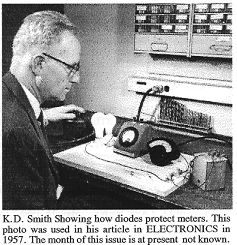
Silicon Diodes Protect Meters published in ELECTRONICS (Month not
known) 1957.
It appears he was still interested in his old project area involving
grown junction transistors, as he published a paper in 1955 relating to
improvements in this area. See the 1951-1952 project coverage before this
chapter.
1956-Retirement
K.D. Smith continued his work on The Bell Solar Battery, in the form
of solar cells that were to ride up into space with both Telstar's I and
II communication satellites.
it in a small packaged form. This effort resulted in the creation
of a development device that was coded M-1752.
The M-1752 pioneered the way for many other forms of grown junction
transistors to follow. K.D and the others that made up the engineering
staff created improved versions that were at the same 50 mW power handling
level as the M-1752 as well as higher power handling devices. The grown
junction triode was to lead to R.L. Wallace's grown junction tetrode, which
led to high reliability and bandwidth in reference to the time frame it
was created in.
All of these devices, except the Sparks and Teal prototype are on
display in the museum for your viewing pleasure! You are able to see how
the device was built, as well as seeing grown junction devices from the
crude prototype stage to the production models that were used by the Bell
System to make our lives more reliable.
During the time that K.D. Smith worked on the development and refinement
of the Grown Junction Transistor he published the following works that
document the efforts put forth on this device at the Laboratories at that
time.
1. Properties of Grown Junction Transistors
National Electronics Conference, where it was presented as a paper
and also was published in the proceedings in October 1952. This paper also
appeared in print in TELE-TECH magazine January 12, 1953.
2. Surge Limitations of Junction Transistors: This was an unpublished
paper presented at the IRE Semiconductor Research Conference June 1953.
3. Grown Junction Transistor Development: Published in the Bell Telephone
Laboratories RECORD magazine October 1955. This article is reprinted here
in VINTAGE ELECTRICS, and provides a very easy-to-understand explanation
of how a grown junction transistor works, and also how one of these devices
is fabricated. This is really some great reading, not only for the beginner,
but for the seasoned professional as well. The article covers background
on the M-1752 as well as later production types used by the Bell System
in production style telephone equipment. Although this article is not of
the 1951-1952 time period covered in this section, it shows that K.D. Smith
continued to keep in touch with the progress of any device or technology
that he was once involved with. In 1955 he was currently involved with
silicon devices that will be covered in the next section.
Aside from these formal presentations and papers, K.D. Smith enjoyed
sharing his knowledge and technology at smaller meetings at colleges and
electronics special interest group
K.D. Smith at Bell Laboratories, Cont.
In a letter to J.M Early during this development effort and after Telstar
I had been launched, K.D. Smith presented some ideas on why the solar cells
output was far more diminished that what had been expected by the proton
fluxes in the van Allen radiation belt and the high altitude atomic tests
that had preceded the launch of Telstar I. This letter that is on file
at the museum, is entitled "Micrometeorites And Damage To Bare Solar
Cells In Earth Space Orbits" it is dated April 1963.
This data was forwarded to NASA and the suggestions that K.D. Smith
provided in this report are a part of every space borne solar power plant
that has been launched since then.
During this period K.D. Smith co-authored a paper along with F.M.
Smits and W.L. Brown titled "SOLAR CELLS FOR COMMUNICATION SATELLITES
IN THE VAN ALLEN BELT" This paper was presented at the British IRE
convention in Oxford England July 1961, and is of course on file at the
museum.
The Later Years.
K.D. Smith was to spend much time on the development of diode and
transistors that would work at high frequency. We plan to cover this in
detail in the next issue of VINTAGE ELECTRICS, as the area is very large.
Some of the publications at this time were:
"Generating Power At Gigahertz With Avalanche Transit Time Diodes"
In ELECTRONICS, August 8,1966.
"The IMPATT Diode, A Solid State Microwave Generator" Bell
Laboratories RECORD, May 1967, pages 144-148.
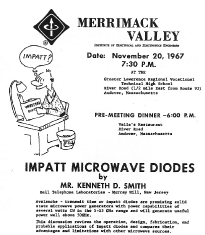
K.D.'s time during his later years at the laboratories are not as
well documented as the early years were, so research is still underway
in this area.
Be sure to read future issues of VINTAGE ELECTRICS to learn more
of the work of K.D. Smith.
Picture of K.D. Smith from his retired Bell Telephone Laboratories
I.D. card. This is the last photo that we have that was taken of K.D. I
would assume it was done in the late 1980's
From Machine Design, January 4, 1962.
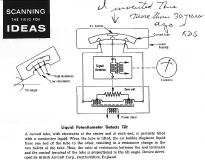
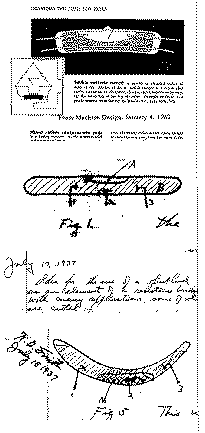
Imagine the surprise when K.D. Smith saw the top article in Machine Design
(year 1962)!
The pictures below are from a 1937 notebook that K.D. kept. (click picture for
larger view)
Although he never applied for a patent on this idea, I would imagine
that he was happy to see that many years later someone else thought of
the same idea!
K.D.'s notebooks are full of ideas such as this one, and you may
view them at the museum library.
Photo of K.D. Smith Ca. 1930. This is what he looked like when he joined
Bell Telephone Laboratories. (need
to scan this)
|